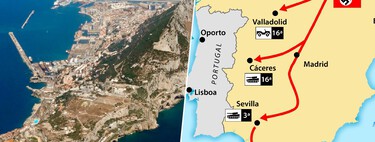When we think about the Second World War, the easiest thing is for us to visualize great battles in scenarios that movies, series and video games have burned into our retinas. Perhaps the two most famous European invasion operations are Overlord and Garden Marketbut beyond the big stages, there were numerous small-scale actions to recover Europe.
The actions carried out by intelligence agencies are less spectacular than major combats, but for many, they are surely more fascinating. And, of all of them, a story that seems untrue is that of the soldier who became General Montgomery’s double to confuse the Nazis about the Normandy landing site. The curious thing? It was a painful double, but after the war the actor got a lot of use out of it.
Confuse about D-Day. If the Normandy landings turned out the way they did, it was due to a series of coincidences, but also due to very good Allied planning. The Nazis knew that something like this would happen and built the Atlantic Wall, a huge containment barrier that, in reality, was not well fortified in much of the territory. Furthermore, control of the different Panzer tank divisions was in too many hands, with Hitler having direct control of some of the most important ones and, without his orders, they could not move.
But beyond attacking at the right time and in a precise way, the allies had several plans to confuse the Nazis about the landing point. That is why Operation Bodyguard was carried out, the umbrella for different smaller operations that had the same objective: to deceive the Nazis. One was Operation Fortress, in which the Allies deployed fake tanks, planes, and barges to simulate that the invasion would take place elsewhere. Another was the use of double agents to confuse the Nazis about the time and point of the landing. And another was…
Copperhead. If some of the Allied intelligence operations were to confuse from the shadows, with Copperhead the idea was different: to expose one of the heads of the British army. It was a decoy operation in which the idea was to ‘walk’ Bernard Montgomery through different points of the Mediterranean to try to divert Hitler’s attention to this point and forget about the landing in the Atlantic.
Dudley Clarke was a British officer who specialized in these deception operations and, after seeing the film ‘Five tombs in Cairo‘, an idea occurred to him. In the 1943 film, a British soldier who had survived a battle against the African Korps In the Sahara he adopted the identity of a hotel waiter who serves as Rommel’s center of operations. It has its twists and turns and is old, but I recommend it. Clarke wondered… what if we could sneak a double of one of our most important figures into the Germans?
The key piece. Bernard Montgomery was one of the key players in the British Army during World War II. He served on the Western Front and commanded the British Eighth Army during the Eastern Desert Campaign, among other operations. If a double was made of someone, it had to be him. And the logic was perfect.
Being such an important figure for the British, in the event of an invasion, Montgomery would surely be directly involved. Wherever Montgomery was, there would be the invading British forces, but of course, there was a problem: the Nazis also had their intelligence service and Montgomery was going to be monitored. The idea? Have Montgomery go on tour, but not the real one (who had to continue fulfilling his role in the army), but a double.


On the left, the real Montgomery. On the right, Clifton
Casting. The only way to fool the Germans was for Montgomery to actually be in two places at once. And, of course, they started looking for a double. Clarke came up with a few names, but none of them fit the profile. That is, it was 1944, but the Germans knew perfectly well what Montgomery was like and he couldn’t be someone very tall… or very short. Nor with physical characteristics that the true general does not have.
However, everything changed when a team member saw a photo of Clifton James in the News Chronicle newspaper. James was an Australian born in 1898 who served at a young age with the British Royal Fusiliers in the First World War. When the conflict ended, he was bitten by the acting bug and was performing roles until the Second World War broke out. Without thinking, he enlisted in the Royal Army Pay Corps. And it was… perfect. Well, more or less.
An imperfect double of method. Clifton resembled Montgomery physically and was called in for a screen test for a new film. The thing is that it was not for a movie, but rather a strategy for the actor to attend a meeting in which he would be assigned his new role: Montgomery’s double.
It was far from being perfect: He lost a finger during the First World War and had to wear a prosthesis, he smoked and liked—too much—to drink. The real Montgomery had his 10 fingers, was teetotal and hated tobacco, so it was crucial that Clifton was not seen either raising his elbow, or smoking, or… harmed by alcohol. Montgomery gave the actor its approval (despite everything), and he He spent a few days following Bernardstudying all his movements. Not only did he have to be a convincing Montgomery for the Nazis, but for anyone who came across him: people had to think he was the real ‘Monty’.
Oh, the gin… Operation Copperhead couldn’t have started in a worse way. On May 26, 1944 (D-Day was June 6), Clifton, now disguised as Montgomery, flew from a British base to Gibraltar. The Germans were monitoring the entire area from the Spanish border, so they were sure to see General Montgomery himself land. However, the plane did not land when it was supposed to. The reason? James himself is said to have snuck a bottle of gin on the flight and finished it. He was impaired and they couldn’t let the Germans see him like that, so the plane circled several times until he got over his drunkenness.


Wait, if Monty doesn’t smoke…
A few days later, things were not much better in Algiers. The fake Montgomery was displayed around the airport and meetings were simulated with other generals to discuss an apparent operation against the south of France. The problem was that the operation was complicated by rumors that Clifton had been seen staggering and smoking on the city streets. The Allies hid Clifton and maintained the illusion that Montgomery was still in North Africa. In the end, D-Day arrived, the real Montgomery landed in Normandy and… Clifton returned to serve in the Pay Corps.

Without further ado. 10 pounds per day worked (the same as the real Montgomery earned during the operation) and the condition not to talk about this to anyone for the duration of the war. This is how the actor’s adventure came to an end before returning to his role as a soldier and, despite these rumors of behavior unbecoming of the real general, Clifton made an effort in his characterization. But most importantly: did he manage to fool anyone?
It is known that Operation Fortress and the double agents were of great use to the Allies, but Copperhead’s usefulness is less clear and remains a matter of debate. And not because the Germans caught Clifton drunk, but because the Germans themselves stated that they believed that moving Montgomery around Europe so much was part of a deception operation (they did not know that he was a double, but they knew that something was afoot) and other parts of Operation Bodyguard had already been instrumental in confusing the Nazis, without Copperhead adding much to that confusion.
‘I was Monty’s double’. Life just after the war was not easy for Clifton. He couldn’t get a job easily and had no money, so he had to ask for benefits unemployment to support his family. However, Montgomery was the role of a lifetime and, in 1954, Clifton published a book called ‘I Was Monty’s Double‘—’I was Monty’s double’—.
This book was adapted to film in 1958 in a film of the same name in which James played both himself and Montgomery, again. Clifton died at the age of 65 at his residence in Worthing and, although according to various sources his operation was not decisive, he did fulfill a role of which he should have been proud.
Both for the service provided and for the challenge it was to interpret someone like Montgomery in a vital situation such as the preambles of the largest operation of World War II.
Images | The Colborne Express, Grenavitar
In Xataka | The Nazis already created synthetic gasoline in the 1930s. Nothing prevents us from doing the same today



![[Img #74675]](https://thelatestnews.world/wp-content/uploads/2024/12/They-discover-a-new-class-of-X-ray-sources-in-the-150x150.jpg)









![[Img #74675]](https://thelatestnews.world/wp-content/uploads/2024/12/They-discover-a-new-class-of-X-ray-sources-in-the-300x200.jpg)


Add Comment